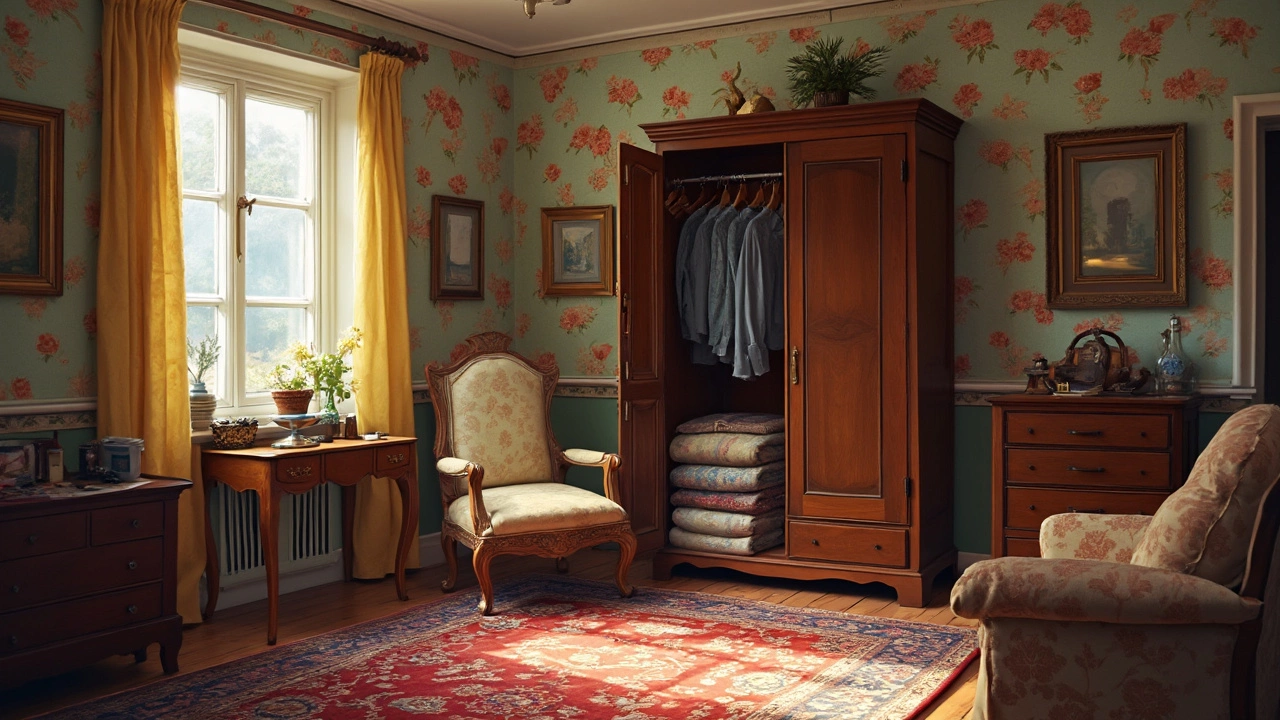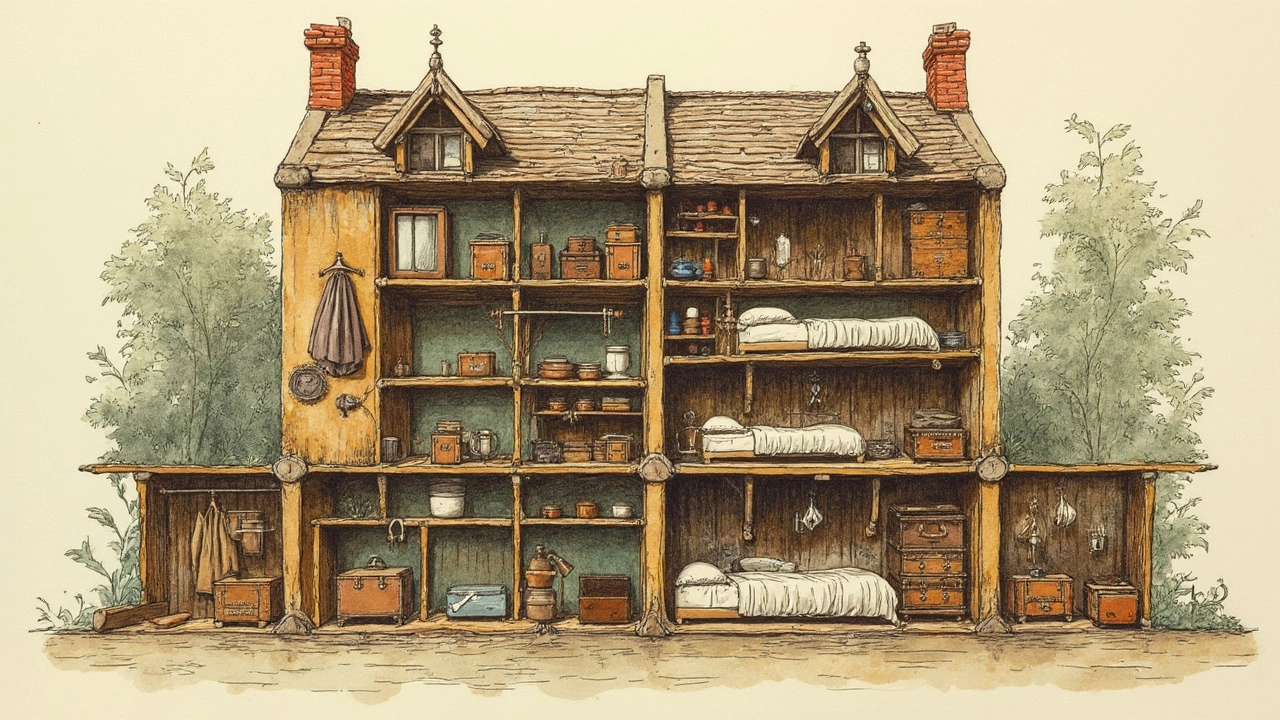Why Are There No Closets in Old Houses?
 Mar, 17 2025
Mar, 17 2025
Stepping into an old house is like traveling back in time. There's so much history, charm, and... a surprising lack of closets. Ever wonder why? It all boils down to a few key factors that shaped home design back in the day.
Back in the late 19th and early 20th centuries, people simply didn't own as much clothing and personal stuff as we do today. Most had what they needed and not much more, which meant huge storage spaces weren't necessary.
It's also worth noting that taxes played a role. In some areas, a home was taxed on the number of rooms. Closets, if counted as rooms, would increase the homeowner's tax bill, so builders often avoided including them.
But old houses aren't doomed to a life of clutter. There are plenty of clever ways to transform these charming spaces into organized havens. From incorporating furniture pieces that double as storage to using nooks and crannies creatively, it’s completely possible to blend modern storage solutions with vintage aesthetics.
- Historical Perspectives
- Lifestyle Changes Over Time
- Comparison with Modern Homes
- Innovative Storage Solutions for Old Houses
Historical Perspectives
So, why exactly do old houses lack closets? It wasn't just a design oversight. A closer look at history shows us a world where the very concept of a closet was a luxury.
Old houses were built in eras when people owned fewer personal items. Most families had just a couple of outfits each, making the need for expansive storage pretty limited. Instead of built-in closets, they used furniture like armoires and wardrobes to store their clothes. These pieces were often seen as a symbol of wealth, so their prominence in a room showed off the homeowner’s status.
Economic Considerations
Taxes also influenced the structure of homes. Back in the day, property taxes were sometimes based on the number of rooms. A closet counted as a room, so builders skipped adding them to keep homes more affordable.
Design Trends
Architectural styles have morphed significantly over the years. Early American homes were built to be functional and compact to conserve resources and minimize heating. Today’s open floor plans and spacious designs were uncommon. The focus was largely on the essentials, making closets a non-priority.
It's fascinating how these factors culminated in the cozy yet storage-poor homes we prize today for their character and charm. Next time you step into a vintage home, take a moment to imagine the simplicity of life back then, sans the need for walk-in storage solutions.
Lifestyle Changes Over Time
Our lives have changed a lot over the past century, and so have the homes we live in. Back in the day, the idea of having dedicated spaces for clothes, like the now-common closets, wasn't a big deal for most households.
In the early 1900s, according to the U.S. Census Bureau, the average American owned around 9 outfits total. Fast forward to today, and that number has skyrocketed, reflecting how lifestyle developments spur the need for different storage solutions.
Clothing Boom
The rise of the garment industry and faster production techniques introduced affordable fashion to the masses. People started accumulating more clothing, and suddenly, the need for proper storage took center stage.
"The roaring twenties saw not just a fashion revolution but also a shift in storage needs," notes Dr. Alice Jenkins, a historian at the National Museum of American History.
Home Design Evolution
As folks started buying more stuff, post-war American homes adapted with larger wardrobes and custom-built closets. New home design trends favored built-in storage as a standard feature, replacing freestanding wardrobes that were common in older homes.
Tables of Changes
| Year | Average Number of Outfits |
|---|---|
| 1910 | 9 |
| 1950 | 20 |
| 2020 | 30+ |
All these changes mean modern homes need space to handle everything from tech gadgets to a vast array of seasonal attire. Looking back, it's clear why old houses seem short on closet space: our ancestors simply navigated life with much less stuff.

Comparison with Modern Homes
The difference between old houses and modern homes is like night and day when it comes to closets. Today, most new constructions come equipped with spacious walk-ins or built-ins that seem almost standard, driven by our modern love for convenience and organization.
In older homes, you'll often find tiny closets, if they're there at all. Why? Well, these houses were built during a time when people owned fewer clothes and household goods. Meanwhile, homes built in the last few decades are influenced by consumer culture—they cater to storing our growing collections of clothes, gadgets, and gizmos.
Modern homes don't just mean more space; they also mean improved design. Sliding and mirrored doors maximize space while adding style. High ceilings in modern homes create opportunities for vertical storage which isn't as common in older buildings.
Big Shift in Home Designs
This change in design philosophy didn't just happen overnight. It stems from the societal shifts in the late 20th century. Rapid advancements in production meant that consumer goods became cheaper and more accessible, driving the need for more storage.
Take a look at the following table that highlights some stark contrasts:
| Feature | Old Houses | Modern Homes |
|---|---|---|
| Closet Space | Limited or none | Ample with walk-ins |
| Storage Design | Basic shelves and racks | Customizable systems |
| Size | Small rooms | Open-plan spaces |
No matter how advanced, modern homes sometimes lack the character and aesthetic appeal inherent in older structures. Fortunately, striking a balance between maintaining the charm and enhancing functionality is totally doable with a bit of creativity.
How so? By incorporating versatile storage solutions that blend well with the historical aspects of old houses. This way, you get the best of both worlds—style and substance.
Innovative Storage Solutions for Old Houses
Even if your old house lacks closets, don't worry! There are plenty of clever storage fixes that can fit seamlessly into the existing charm of your home. Whether you live in a vintage Victorian or a cute cottage, these ideas will help you make the most out of every nook and cranny.
Utilize Vertical Space
Vertical space is often underused. Consider installing tall, wall-mounted shelves that reach up to the ceiling. This not only provides ample room for books, storage bins, and decor but also draws the eye upward, creating an illusion of more space.
Furniture with Dual Purposes
Invest in furniture pieces that offer more than one function. Think of beds with built-in drawers, coffee tables that open up to reveal storage inside, or benches with internal compartments. These pieces are perfect for storage solutions because they integrate seamlessly into living areas without adding clutter.
Hooks and Pegboards
Hooks and pegboards are your best friends in old houses. They are not only super affordable but also easy to install and remove. Use them in the kitchen for pots and pans, in the entryway for jackets and bags, or anywhere you need extra holding space.
Storage Under Stairs
If there's a staircase in your home, don't ignore the space beneath it. This can be converted into a compact but highly efficient storage area. Think pull-out drawers, shelving, or even a tiny office nook. It’s a classic trick to make the most out of otherwise wasted space.
Baskets and Bins
Don't underestimate the power of baskets and bins for organizing your stuff. They’re easy to move and can fit into lots of places, like under tables, in shelves, or tucked in corners. They're perfect for storing everything from toys to seasonal clothes.
Creative Partitioning
Old homes often have large, spacious rooms. You can strategically divide these spaces using bookshelves or dividers, which not only create defined areas but also offer plenty of extra storage.
| Storage Solution | Best For |
|---|---|
| Wall-Mounted Shelves | Books and Decor |
| Duel-Purpose Furniture | Living Rooms and Bedrooms |
| Hooks and Pegboards | Kitchen and Entryways |
| Understairs Storage | Compact Areas |
| Baskets and Bins | Miscellaneous Storage |
With these storage solutions, living in an old house doesn't mean you have to sacrifice organization. You'll be amazed at how these small changes can free up space and add functionality without losing any vintage charm.